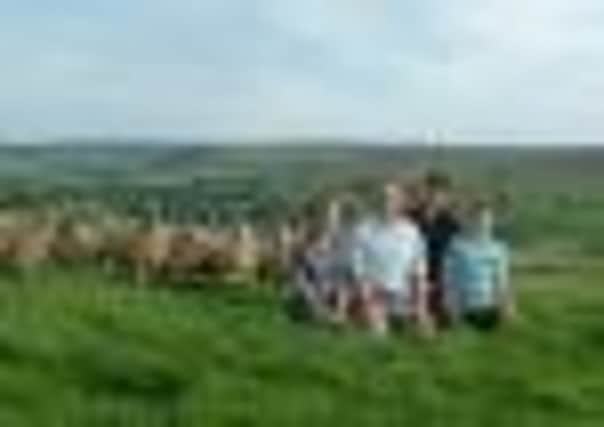Farmers in quest for golden fleece


It’s payday time for the sheep breeders of Wensleydale and Swaledale during September with a series of annual sales.
The biggest of them all is the North of England Mule Sheep Association (NEMSA) sale where 32,000 ewes are sold over two days at Hawes and if last year’s average price holds up, over £3.5m will change hands through the market.
Advertisement
Hide AdAdvertisement
Hide AdThe Porter family has farmed at Reeth since 1908 and their 250-acre Riddings Farm has been home to Mule sheep since the hybrid became popular around 40 years ago.
They also have 40 dairy cows, but it is their sheep enterprise that takes precedence. They have 220 Swaledale ewes that they put to the Swaledale tup; and 350 are put to the Blue Faced Leicester tup in order to produce the Mule gimmers.
They will be taking 200 gimmer lambs to Hawes Farmers Auction Market on the first day of the sale on Monday, September 17.
Although they don’t anticipate last year’s overall average price of around £115 per ewe will be matched, they are confident that their quality has been maintained in order to be competitive.
Advertisement
Hide AdAdvertisement
Hide AdGeoffrey Porter, his wife Valerie and his father James were all busy preparing their sheep earlier this week. Having competed at Kilnsey and Reeth shows last week Geoffrey explains why the forthcoming sale is so important.
“Nearly everybody in this valley will be there. It’s the biggest sale we attend and the standard of stock gets better every year, so you have to keep improving. It’s also the one where most buyers attend and that competition is what can hopefully drive the price.”
The North of England Mule is a crossbred of the Blue Faced Leicester tup on the Swaledale ewe. It is bred in the hills and makes an ideal lowland sheep breed as the Mule ewes make excellent mothers and are very prolific.
This combination ensures that the lowland farmer is able to make the best out of each Mule gimmer he buys. The hardiness of the Swaledale linked with the prolificacy of the Blue Faced Leicester has led to the Mule becoming the country’s most popular lowland ewe.
Advertisement
Hide AdAdvertisement
Hide AdBut the Porters don’t take anything for granted even though they have been involved with Mules ever since changing from Mashams 40 years ago. Geoffrey knows that it’s vital to get things right and believes in correct preparation.
“We use the agricultural shows closest to the sale to give them a run out. They don’t take a lot of preparing, unlike the Swaledales that need a great deal more time.
“It’s a quick snip and clip, a wash and some colouring, then they’re ready. We did well at Reeth Show last week, getting a second place, but we weren’t so high up at Kilnsey Show. That’s a very strong show and I’d say our lambs were probably better than they have been for three or four years, yet fifth was the best we could manage.”
“We expect the prices at Hawes to be a little bit down on last year, although hopefully not by too far.
Advertisement
Hide AdAdvertisement
Hide Ad“One or two of the early sales elsewhere only saw a drop of around £2 to £5 and we’d be happy with that. It’s the fat lamb price that dictates the market and that hasn’t been quite so good.
“Everybody said higher prices couldn’t last but you’ve just got to make the most of them when they’re around.”
Attracting the best prices isn’t all necessarily down to the quality of your stock.
Because the sales are so big, swelling the market town’s population over the weekend prior and the two days of the sale, exactly when your sheep are sold during that time can be crucial. Such events as the NEMSA Gimmers Sale are managed on a ballot system, which decides the order of farmers’ stock. James Porter has seen how this can affect the price.
Advertisement
Hide AdAdvertisement
Hide AdWhile the Hawes sale is the biggest sheep sale of the year, there are also big sales at Kirkby Stephen and Bentham in the days leading up to it. During August and September over 200,000 Mule ewes will have been sold, migrating from hill farms to lowland enterprises. It’s the way the UK sheep system works best.
But the daddy of all the sheep sales around this time of year is surely the Blue Faced Leicester tup and ewe sale at Hawes. If you’re looking for a real test of endurance in the livestock market, this is the one for you.
“It starts at 9am and has been known to finish at 2am the next day. Because of when the sale sometimes falls you can have the sale in one month and it finishes in the next one!
“Everybody likes to buy a fresh tup because we all want to carry on improving. We also breed our own Blue Faced Leicester tups, as we have 50 ewes. Breeding livestock is a passion and buying fresh bloodlines with the hope that they are better than what you’ve had before is what we all want to achieve.
Advertisement
Hide AdAdvertisement
Hide Ad“The top price we have paid for a tup is £20,000 as a part share with other Mule breeders.
“It’s all down to breeding a better ewe or ram lamb that means you can earn more when the gimmer and ram sales come around. The gimmer sales are our bread and butter, to sell our own tups is our bonus.”